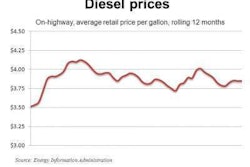OEMs bullish on 2012 truck sales
As equipment replacement drives truck demand, what will it take for carriers to expand their fleets?
By any measure, 2011 was a good year for truck manufacturers. Class 8 North American truck sales last year were up roughly 53 percent. When compared to the bottom of the truck market in 2009, truck sales are up a whopping 82 percent.
Truck sales were so brisk, in fact, that OEMs began running out of production slots for the year as early as May. Last March, Volvo Trucks North America added 700 jobs and ramped up production at its plant in New River Valley, Va., and just last month, Daimler Trucks North America announced the addition of 1,100 jobs at its Freightliner plant in Cleveland, N.C., to meet truck order demand.
 Class 8 North American truck sales were up roughly 53 percent in 2011.
Class 8 North American truck sales were up roughly 53 percent in 2011.“2011 is where we feel like we have turned the corner and are back to what we would call a normal marketplace in terms of truck production,” says Mark Lampert, DTNA senior vice president of sales. DTNA’s current 2012 forecast is 253,650 units for the U.S., Canadian and Mexican markets.
At a press event last month, Volvo Trucks also forecasted a total Class 8 truck market of roughly 250,000 units, representing about a 20 percent increase from 2011.
Large year-over-year increases in truck orders typically occur as carriers add capacity – or, as was the case in 2006, a pre-buy occurs. This time around, however, the vast majority of new truck orders – as much as 95 percent – can be attributed directly to replacement demand. With the average truck age approaching seven years, more fleets will be forced off the sidelines to purchase new trucks to replace aging ones with high mileage and high maintenance costs.
While this is welcome news for OEMs, it’s not necessarily indicative of momentum for the trucking industry. In 2011, freight rates firmed up and capacity remains tight, but by and large, carriers remain hesitant to grow their fleet size.
So what will it take to spur real growth in the trucking industry?
Industry regulations including Compliance Safety Accountability and the new hours-of-service final rule – due to come on line mid-2013 – will crimp industry productivity and drive up demand for new trucks as much as 6 percent in coming years to offset reduced hours of work.
But the best indicator, said economists during the Heavy Duty Dialogue 2012 conference last month, is Gross Domestic Product. According to Eli Lustgarten, senior vice president for Longbow Securities, any economic growth in the 2 to 3 percent range is enough to keep truck demand stable. Anything above that likely will spur growth.
“If you’re over 3 percent GDP, you could have a 300,000-plus market,” says Lustgarten, referring to NAFTA truck sales. “But if you’re at 2 to 2.5 percent, it’ll probably be a little weaker, in the 280,000 range.”
Of course, larger-than-expected truck orders could wreak havoc for suppliers – as evidenced last year when suppliers struggled to keep up with truck orders. “The supply situation absolutely put a lid on truck production in 2011,” says Lampert.
“The [supplier] industry absolutely cannot sustain production at the fourth-quarter 2011 rate for 2012,” says Lustgarten.
“Capacity-wise, we have increased efficiencies to get better yield out of one shift compared to pre-crisis,” said Ron Huibers, president of North American sales and marketing for Volvo Trucks. As the economy rebounds, “lead times could increase, and that’s not far off in the distance.”
When carriers move beyond replacement and into fleet expansion is not a question of if but when GDP steadily climbs 
JEFF CRISSEY is Editor of Commercial Carrier Journal. E-mail [email protected].












